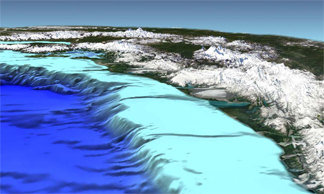Interplay of Collisional Tectonics and Late Cenozoic Glacial Climate in Alaska and the Northeastern Pacific Ocean
May 5-6, 2003 – Austin, Texas
Convener: John Jaeger, Sean Gulick

Summary
Due to the variety of climatic and tectonic processes that interact through the orogenesis of a glacially dominated coastal mountain belt such as the St. Elias range, a wide scope of expertise and techniques must be brought to bear for making a fundamental leap forward in our understanding of such systems globally. To that end, a workshop, funded jointly by the National Science Foundation-Continental Dynamics program and the Joint Oceanographic Institutions, was held that brought together researchers interested in using the southeastern Alaska region (i.e., coastal mountains, continental margin, Gulf of Alaska abyssal plain) as an in situ natural laboratory to study tectonic-climatic interactions in a glacial environment. Fifty-seven scientists attended the workshop and represented the fields of tectonophysics and geodynamic modeling, terrestrial and marine observational geology, geomorphology and geophysics, GPS-based geodesy, glaciology, glacimarine geology, micropaleontology, palynology, paleomagnetics, paleoclimatology and paleoceanography. Because of the broad scientific scope of these issues, the most productive way to begin to address them is by fostering synergistic collaboration among the ocean drilling, glaciology, tectonophysics, and climate dynamics communities. By bringing together such a diverse group of earth scientists, it was possible for the first time to outline the science issues associated with gaps in our understanding of the linkages between late Cenozoic collisional tectonics and climate in Alaska and the northeastern Pacific Ocean. The two-day workshop consisted of a brief number of keynote presentations, thematic poster sessions, and a series of interdisciplinary breakout sessions to identify integrated terrestrial, marine, and modeling issues and priorities. The product of this workshop is a science plan that summarizes the state of knowledge of the relevant topics, provides a list of detailed scientific questions, and contains suggestions for implementation.
Steering Committee
Sean Gulick (co-chair), University of Texas at Austin
John Jaeger (co-chair), University of Florida
John Armentrout, Cascadia Stratigraphics
Jeff Freymueller, University of Alaska Fairbanks
Peter Koons, University of Maine
Terry Pavlis, University of New Orleans
George Plafker, U.S. Geological Survey
Ross Powell, Northern Illinois University






